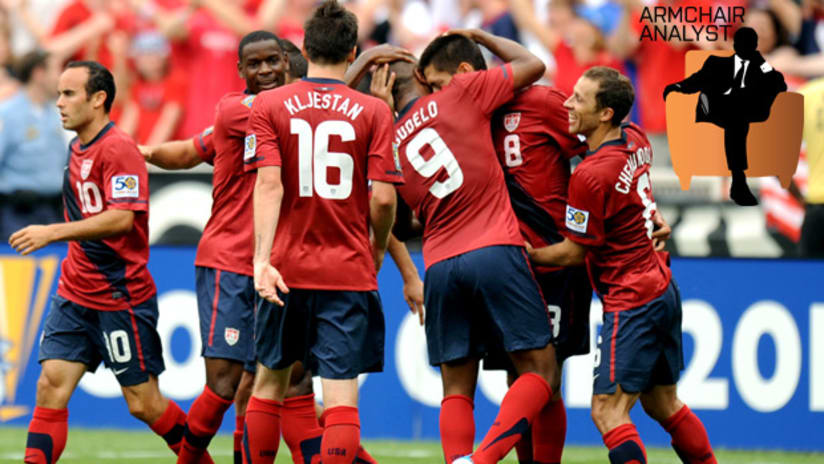So, as usual, it comes down to US vs. Mexico. The featured attractions lived through tainted meat and injuries, scoring slumps, upsets and extra time to play the final day.
And here we are.
The US, for the first time in a generation (in soccer terms, anyway), are playing a Mexico team that is not just favored, but heavily so. El Tri have the goal-scorer they’ve lacked since the days of Hermosillo and El Matador, have other attackers who can get him the ball, have youth and speed and confidence and — for the first time in more than a soccer generation — a coach who seemingly has the good will of both the country and the Mexican Federation.
How to beat them?
DENIAL OF SERVICE ATTACK
The best way to kill a dragon is to cut off its head, but Mexico are more like a hydra. They’ve many heads — Gio dos Santos, Pablo Barrera and Andrés Guardado can all break a man down off the dribble and feed the beast that is Javier “Chicharito” Hernández. Efraín Juárez and Carlo Salcido are both more than capable of pushing into the attack and putting service on a plate.
They get it wide, get isolated, and force the defense to backpedal. That makes the trap harder to pull, and inevitably, invariably, at some point Chicharito beats the defense to the near post, the trap fails and the final pass is delivered.
The US have to prevent Mexico from ever getting into those spots in the first place.
You can’t do it with Chicharito — he’s going to make his off-the-ball runs no matter what — but you can keep the ball away from the flanks and force Gerardo Torrado and Israel Castro to initiate the attack.
This is where the Yanks have their best chance of winning the game.
Castro and Torrado are, at this point, just “OK” players. Both in their 30s, both at a point where they’ve played almost nonstop for the past year and coming off a 120-minute extra-time affair against a very rugged and very game Honduras, their tanks should be nearing empty.
Bob Bradley must have his team press them both. Don’t have two deep-lying central midfielders (usually Michael Bradley and Jermaine Jones) sitting back and sharing roles. Instead, unleash Michael and have whoever’s playing just underneath the lone forward — it’s a given the US will play with a lone forward, right? — stay on Torrado and Castro to deny them the time to switch fields and find their flank players in space.
That is what Mexico does best. Time and again they use quick combinations to pull a defense out, then dos Santos and a fullback push up to create a numbers-up situation. If the outlet pass is precise, the ball is received in stride with a retreating defender forced to choose whether to stay with the ball or the overlap.
Neither choice can be right every time. It’s scrambling defense, and while the US scramble as well as almost anyone, Mexico likewise punish scrambles as well as almost anyone.
The only choice is to deny service to Giovani, Guardado and Barrera. Do that and you deny service to Chicharito. Force Torrado and Castro to build attacks through the middle and make the pass square.
That’s the key. If you force Mexico to pass the ball square, they won’t pull your defense out of position. They won’t have the US defense on their heels, they won’t be able to isolate the fullbacks and they won’t be able to provide enough service to Chicharito.
The bonus is that you funnel them toward Jones, who has great instincts as an outlet passer when starting the break. It also keeps Michael Bradley higher up the pitch, giving Jones another outlet and adding another finisher to the US attack.
A TRUE 4-5-1
The other aspect is making sure the “fifth” midfielder — Sacha Kljestan started in that spot each of the last two games — is actually positioned as a true midfielder instead of an enganche. It will make the US more stagnant in possession, but the US have out-possessed Mexico exactly zero times in the rivalry’s history, and Saturday’s a lost cause on that front already anyway.
Adding Kljestan (or Freddy Adu, or Landon Donovan) to the central midfield proper means having another body to press Mexico’s central midfield, and another body to track out to the wings and help on overlaps.
It will be ugly, as it’s more about destroying the flow of the game than it is about creating anything. But it’s a tactical approach that both Guatemala and Honduras used to great effect against El Tri, and with all due respect to those two sides, the US have better personnel on hand to pull it off.
WILL IT BE ENOUGH?
Even if the US execute this (or some other) gameplan perfectly, it may not be good enough to beat this Mexican team. For all their on-the-ball trickery, this version of El Tri is most notable for how sound they are fundamentally. They’re well-trained to jump on defenses that lose their shape, they make great off-the-ball runs, and they’re unselfish.
That means the US will have to excise the simple mistakes they’ve been making, not leave the gaps that other, lesser CONCACAF sides have exploited. If they don’t, it could get ugly.
As usual, it’s US vs. Mexico. And as usual, it’s a tall order.
Matthew Doyle can be reached for comment at matdoyle76@gmail.com and followed on Twitter at @MLS_Analyst.















